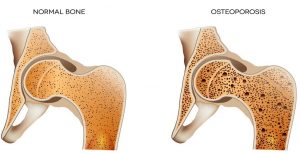
by Dr. Brijesh Valsalan, Specialist Orthopaedic Surgeon, Thumbay Hospital Day Care, Rolla, Sharjah
Women and bone strength
Several medical problems affecting women are neglected by the women themselves as well as their families, due to various socioeconomic factors. The modern-day working woman is under a lot of physical and mental stress as she has to cope with stress at home and at the workplace. Often, they don’t get a due appreciation for all the effort they make. This increased stress is also bound to take a toll on their bodies. This article aims to discuss a common bone-related problem in women, namely, Osteoporosis.
Biologically females are at a disadvantage in terms of bone health. Their bone size and density are lower than males and hormonal levels are very important in maintaining bone health. In both males and females, peak bone strength is achieved between 18 & 25 years of age. This explains why most elite athletes across all fields are usually in this age group. After reaching 30 years, a person’s bone strength tends to decline. However, the rate of decline is influenced by various factors, with the levels of physical activity becoming a decisive factor.
Those who are physically active tend to preserve bone strength for longer periods, compared to the sedentary ones who lose it faster. In females, the level of the hormone oestrogen influences bone strength. Oestrogen is protective for bones and the decline in oestrogen levels after 40 years of age also mirrors the decline in bone strength. After menopause, there is a rapid decrease in bone strength, and this can lead to Osteoporosis.
What is Osteoporosis and why should I be concerned?

Osteoporosis is a condition in which bones are abnormally brittle and fracture easily. WHO has defined the criteria for diagnosing osteoporosis and it is based on the measurement of bone density. Osteoporosis makes bones brittle without our knowledge and makes them liable to break easily even from minor falls. It is estimated that 1 in 2 women and 1 out of 4 men will experience a fracture due to osteoporosis after 50 years of age.
How is Osteoporosis diagnosed?
Osteoporosis is diagnosed based on history, physical examination and certain investigations of which the main one is a DEXA test.
DEXA/DXA?
Bone density is measured using a test called DEXA/DXA. DEXA (Dual Energy X-ray Absorbsiometry) is a specialized radiological test in which 2 x-ray beams with different energy levels are directed at the patient’s bone and based on a rate of absorption of each bone, its mineral density (BMD) is derived. It is commonly expressed as T-score and Z-score. T-score compares the patient’s bone density with that of a
young adult and Z-score, with that of age-matched value. Not everyone in the population has the same density and just as is the case with all biological values, it lies in a range. Anyone outside the range is abnormal which in this case is fixed by WHO as 2.5 SD (standard deviation below normal). A T-score of -2.5 and below is suggestive of Osteoporosis. A T-score of -1.0 and below is categorized as Osteopenia, in which bones are weak but not to the extent of osteoporosis.
Clinically, we also use a score called FRAX score which is derived from multiple patient parameters and gives a likelihood of fracture risk in the future. It can be derived independently of or with the addition of T-score.

What factors put you at risk of developing Osteoporosis?
- Age: Osteoporosis to some extent is inevitable in old age, in both genders.
- Menopause: As discussed earlier, after menopause oestrogen hormone levels decrease rapidly in women leading to high risk of Osteoporosis. Those who attain menopause before 45 years and ladies undergoing removal of uterus/ovaries due to gynecological issues are also at higher risk.
- Thinner and smaller people tend to have weaker bones and hence are more likely to develop Osteoporosis.
- Lack of exercise also is an important factor, as weight-bearing exercises like walking, jogging, running and lifting weights help preserve bone strength. This puts people following a sedentary lifestyle at a bigger threat of Osteoporosis.
- Smoking.
- Alcoholism.
- Excessive caffeine.
- Hereditary factors: Osteoporosis tends to run in families; so if your mother/grandmother had been diagnosed, there is all the more reason for you to take extra care.
- Dietary habits: Diets low in calcium and vitamin D.
- Medications – Certain medications, especially corticosteroids puts you at high risk.
- Certain medical conditions like liver disease, kidney disease, Rheumatoid arthritis, thyroid disorders, malabsorption syndromes, Type-1 Diabetes, and Chronic Obstructive Airway Disease.
How to prevent Osteoporosis?
- Following an active lifestyle with regular exercises to maintain bone and muscle strength.
- Avoiding smoking, alcohol and excess caffeine.
- Adopting a balanced diet rich in calcium and vitamin D.
How is Osteoporosis treated?
Osteoporosis treatment starts with assessing all risk factors and taking preventive measures, improving the diet and following certain prescribed medications which help in preventing the breakdown of bone and preserve bone strength.
Commonly available are a class of medications called Bisphosphonates (available as tablets and as yearly injections), Denosumab (injection) and Teriparatide (injection). Calcium and vitamin D are also prescribed commonly.
Patient education is very important, especially for elderly people, with regard to fall prevention. Certain measures at homes like installing supports/railings, avoiding loose rugs and slippery floors, etc. are very important to prevent the risk of fracture from fall.
It is important for everyone at risk to be aware and seek medical attention, as Osteoporosis is aptly called “silent disease”. Bone loss happens without one’s knowledge and the first symptom might well be a fracture following a trivial injury.

Dr. Brijesh Valsalan
Specialist Orthopaedic Surgeon
Thumbay Hospital Day Care, Rolla – Sharjah
For appointments contact us through
Phone: +971 06 5440555
Email: thdaycare.shj@thumbayhospital.ae
Online: www.thumbayhospital.com/dc-rolla/appointments/
Location: Thumbay Hospital Day Care, Rolla – Sharjah | P.O. Box 77773 Rolla – Sharjah, UAE
